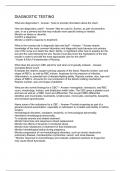DIAGNOSTIC TESTING
What are diagnostics? - Answer- Tools to provide information about the client
How are diagnostics used? - Answer- May be used to: Screen, as part of preventive care, or as a primary test that may indicate more specific testing is needed. Monitor an illness or disorder.
Confirm a diagnosis.
Monitor a client's response to treatment.
What is the nursing role in diagnostic labs and test? - Answer- " Nurses require knowledge of the most common laboratory and diagnostic tests because one primary role of the nurse is to teach the client, family, or significant other how to prepare for the test and the care following the test. Nurses must also know the implications of the test results in order to provide the most appropriate care for the client"*
* Kozier & Erb's Fundamentals of Nursing
What does the acronym CBC stand for and when is it typically ordered. - Answer- Complete Blood Count
Evaluates the relative oxygen-carrying capacity of the blood. Reports number, size and shape of RBC's, as well as RBC indices. Assesses for the presence of infection, inflammation, or potential lack of disease-fighting ability. Reports number, size, type and
shape of WBC's. Accounts for one component of the blood's clotting mechanism. Reports number, size and shape of platelets
What are the normal findings for a CBC? - Answer- hemoglobin, hematocrit, and RBC count, morphology, indices, and distribution width index. The CBC gives a platelet count
and size as well as, a WBC count and differential. The six-part WBC differential identifies and enumerates neutrophils, lymphocytes, monocytes, eosinophils, basophils,
and immature granulocytes.
Name some of the indications for a CBC. - Answer- Provide screening as part of a general physical examination, especially on admission to a health-care facility or before surgery.
hematological disorders, neoplasm, leukemia, or immunological abnormality.
Hereditary hematological abnormality.
To evaluate anemia and related treatment.
Monitor blood loss and response to blood replacement.
Monitor the effects of physical or emotional stress.
Monitor fluid imbalances or treatment for fluid imbalances.
Monitor hematological status during pregnancy.
Monitor progression of non-hematological disorders, such as chronic obstructive pulmonary disease, mal-absorption syndromes, cancer, and renal disease.
• Monitor response to chemotherapy and evaluate undesired reactions to drugs that may cause blood dyscrasias. What is the composition and function of blood plasma? - Answer- Plasma is 55% of blood and it is composed of water, salts, plasma proteins. Substances transported by plasma include nutrients, waste products, respiratory gases and hormones
What is the composition and function of the formed elements in the blood? - Answer- Formed elements account for 45% of blood and is composed of Erythrocytes (red blood cells), Leukocytes (white blood cells), Platelets
A CBC assesses the formed elements of an indibidual's blood. How many RBC's are in the normal adult male and female adult. - Answer- 4.6-6.0 million/mm³ (cubic millimeter)
Male
4.0-5.0 million/mm³(cubic millimeter) Female
What is the composition of Blood? - Answer- Plasma 55%, Formed elements 45%,.
If the number of RBC's on the CBC are too high or low, what other areas of the test should the nurse evaluate and why? - Answer- The RBC indices to get a more clear picture
What is the compostion and function of hemoglobin? - Answer- Hemoglobin: composed of heme and a protein molecule that are responsible for oxygen transport
How is Hgb reported on the CBC and what are the normal values for a normal male and
female adult? - Answer- Reported in grams per deciliter (g/dL) Normal adult male: 13.5-
18g/dL Normal adult female: 12-15g/dL
What is the concern if a patient's Hgb is too low? - Answer- The potential for insufficient oxygenation of tissues exists. Usually related to blood loss, anemia, or bone marrow suppression.
What is the concern if a patient's Hgb is too high? - Answer- A high Hgb count is referred to as polycythemia and is usually related to an individual's physiologic need to increase oxygen-carrying capacity.
What does the hematocrit value of the CBC tell you? - Answer- Hematocrit: reports the percentage of RBCs in the plasma. Percentage may not accurately reflect true value if hydration is an issue.
If you are monitoring a patient with anemia what values would you evaluate? - Answer- Hgb/Hct. Sometimes ordered as single test
What is the normal value for the Hct? - Answer- Normal adult male: 40-54%, Normal adult female: 36-46%




